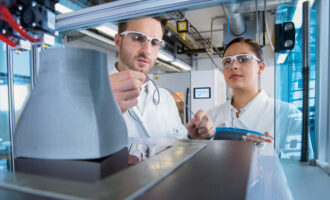A glimpse into the future of manufacturing
By Alison Gaines
Most manufacturers take an average of six years, from start to finish, to build a car, using thousands of parts and producing tens of thousands of units per year. Phoenix, Ariz., U.S.A.-based Local Motors is developing a different approach to manufacturing. The approach involves an online community of more than 49,800 individuals not employed by the company and small, 15,240 square metre microfactories that, according to the company’s CEO and co-founder, Jay Rogers, resemble a cross between “an IKEA store and Formula One.”
The seven-year-old company believes that its philosophy could revolutionise the automotive industry. At the least, it is certainly a glimpse into a true 21st-century way of doing business and making vehicles.

Rogers opened the F+L Week 2015 Conference organised by F&L Asia Ltd. in Singapore in March with a keynote address entitled “Welcome to the Third Industrial Revolution.” This third industrial revolution began, according to Rogers, around the turn of the 21st century. He pinpointed the fundamental difference between today and previous eras: the ways in which we share information. It is no secret that the Internet has changed daily life as well as the dynamics of whole industries. It is also the reason that Local Motors is able to produce a new car design in four months with about 50 parts.
The majority of people involved in Local Motors do not work together in one physical location. From 130 countries, they contribute ideas and comment on the ideas of others as part of an online community. The design for the world’s first 3D-printed car, which Local Motors made in 2014, came from a challenge posed to this community. The winning design, the Strati, came from Michele Anoé of Italy.
3D printing, formally called additive manufacturing, is another component of the third industrial revolution at the disposal of Local Motors and others. The aforementioned Strati has a 3D-printed chassis, exterior body and some interior parts, and prints in 44 hours. Other components, such as mirrors and hubcaps, are added after the body is printed, and all the parts total to fewer than 50. According to Rogers, this project took about four months from its inception to the assembly of the first car in September 2014. The company is embarking, starting in March 2015, on a 23-month endeavour to bring it to market and on the road.
Low-volume manufacturing combined with 3D-printing technology means that modifications are easy to make. If Local Motors had a production line of 17 million vehicles on the road, Rogers said, a recall or a mistake would be a disaster. “The great thing,” he says, “is that we don’t have 17 million vehicles on the road.” A huge factory is no longer necessary because with additive manufacturing, “all I need is a file… and I can go print it out.”
Rogers alludes to the “design, build, sell” model that is often used to describe manufacturing. Local Motors, he says, has turned that triangle into a circle. Additive manufacturing and the Internet allow for the process to be less linear and more circular, which better fosters innovation.
Local Motors’ close relationship with the community is visible in its microfactories as well—customers who purchase a Rally Fighter, Local Motors’ first car, can spend production time at the microfactory, participating in the building of the car and contributing to more than 50% of the car’s making. Additionally, the open source lab in each microfactory attracts local community members who “are so desperate to see the real version of what they’ve been talking about online.” According to Rogers, Local Motors does take its online community into account when thinking about where to build future microfactories. Eastern Europe and Korea, he said, have high concentrations of passionate community members.
Currently, Local Motors’ only microfactory is in Phoenix, and by the fall of 2015, it plans to have two more, one in Knoxville, Tenn., and another in the Washington, D.C. area. All three are in the U.S.A. During the first quarter of 2016, one is planned for Berlin, Germany. At F+L Week, Rogers revealed that Local Motors is planning to have a microfactory in Singapore by 2016 that is capable of producing 3,000 units annually. The company has begun to meet with research institutions, landowners and the government to make this possible.
Singapore is an attractive choice because according to Rogers, the government has said that advanced manufacturing will be 20% of its GDP going forward, which is “a wonderful recipe.” Furthermore, because Singapore is a small island, Local Motors has the opportunity to affect “great change” in the small vehicle population. Additionally, the material with which the 3D-printed car is printed is recyclable. Having a recyclable vehicle, rather than having to scrap it, is an attractive idea anywhere, especially when space is limited as it is in Singapore.
The greatest advantage for Singapore, Rogers said, is the jobs that the microfactory will bring. The microfactory would bring about 200 direct jobs, and as Rogers points out, “introducing vehicles to the market is a large job-multiplier business,” referring to other jobs that would eventually be created.
Singapore places heavy restrictions on vehicle ownership: Owners must pay for a certificate of entitlement (COE) as well as an import duty of 20% and 7% goods and services tax (GST) on the CIF value (cost, insurance and freight) plus the duty payable. Therefore, a locally produced car could attract many customers, at least those that can afford to pay. The current price tag on the Rally Fighter is USD 99,900. Rogers says that the target price for the Strati, when it does hit the market, is between USD 18,000 and 30,000. A big focus right now is reducing the part count, which is part of why the Strati is an electric car— electric cars need fewer parts. “If we can reduce the part count the way we are hoping to, we can make the total cost of ownership even lower,” Rogers said.
Crowdsourcing, which may seem like a buzzword or passing trend, is another way that LocalMotors intends to be profitable. Besides encouraging a certain closeness and loyalty from customers, crowdsourcing is away to have customers fund the products they want in the first place, instead of paying for them after the products are made.
In late 2013, U.S. conglomerate General Electric (GE) asked Local Motors to design a product for a project called First Build. Much like Local Motors’ own online ideas hub, First Build is an online platform where people submit and discuss ideas for innovations in home appliances. (“When I founded Local Motors, I thought that I would only be working in the automotive business,” admits Rogers.) It also offers resources for building, producing and selling the items. The product that Local Motors designed for GE is the Paragon Induction Cooktop. They designed not only the product but also an entire micro-manufacturing methodology. “We were able to make [the cooktop] profitable on a run of only 3,000 units,” whereas GE would normally have produced an initial 20,000.
Through First Build and the crowdfunding site, Indiegogo, GE raised money from its own customers to fund the cooktop. USD 303,468 has now been raised entirely from individuals who want to own the product. “You can’t do that as a large, multinational held corporation that’s owned by the public unless you have promised to develop things openly with the public,” said Rogers, adding that he expects Local Motors will participate in more First Build projects in the future.
Crowdsourcing goes hand-in-hand with Local Motors’ dedication to open-source design. “We would rather disclose, build, make and sell than invent, patent, hold back and wait,” Rogers said. Avoiding patents buys the company speed, one of its most treasured assets. Quick production and turnaround are essential especially with a small run of vehicles. It is another aspect separating Local Motors from big car companies. Rogers acknowledges that manufacturing as we know it today does not need to disappear from the market: big companies “are part of the solution, but they’re not the whole solution.”
It remains to be seen how Local Motors’ future microfactories will play out as well as how successful they will be in selling the 3D-printed electric car, as it is not yet on the market. The company could not be more confident in its philosophy, and it has embraced some of the most quintessentially 21st-century ideas as its own. Time will tell if those ideas will carry them to competition with the manufacturing powerhouses that still dominate today’s automotive market. Rogers understands skeptics and offers this response: “The most exciting thing about the future is that past performance is not a good predictor of future performance.”







